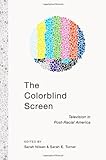The Colorblind Screen : Television in Post-Racial America / Sarah E. Turner; ed. by Sarah Nilsen.
Material type: Computer filePublisher: New York, NY : New York University Press, [2014]Copyright date: ©2014Description: 1 online resourceContent type:
Computer filePublisher: New York, NY : New York University Press, [2014]Copyright date: ©2014Description: 1 online resourceContent type: - 9781479893331
- 791.456552 23
- PN1992.8.M54 C86 2016
- online - DeGruyter
| Item type | Current library | Call number | URL | Status | Notes | Barcode | |
|---|---|---|---|---|---|---|---|
 eBook
eBook
|
Biblioteca "Angelicum" Pont. Univ. S.Tommaso d'Aquino Nuvola online | online - DeGruyter (Browse shelf(Opens below)) | Online access | Not for loan (Accesso limitato) | Accesso per gli utenti autorizzati / Access for authorized users | (dgr)9781479893331 |
restricted access online access with authorization star
http://purl.org/coar/access_right/c_16ec
The election of President Barack Obama signaled for many therealization of a post-racial America, a nation in which racism was no longer adefining social, cultural, and political issue. While many Americans espouse a“colorblind” racial ideology and publicly endorse the broad goals ofintegration and equal treatment without regard to race, in actuality thisattitude serves to reify and legitimize racism and protects racial privilegesby denying and minimizing the effects of systematic and institutionalizedracism.In The Colorblind Screen, the contributors examinetelevision’s role as the major discursive medium in the articulation andcontestation of racialized identities in the United States. While the dominantmode of televisual racialization has shifted to a “colorblind” ideology thatforegrounds racial differences in order to celebrate multiculturalassimilation, the volume investigates how this practice denies the significantsocial, economic, and political realities and inequalities that continue todefine race relations today. Focusing on such iconic figures as PresidentObama, LeBron James, and Oprah Winfrey, many chapters examine the ways in whichrace is read by television audiences and fans. Other essays focus on how visualconstructions of race in dramas like 24, Sleeper Cell, and The Wantedcontinue to conflate Arab and Muslim identities in post-9/11 television. Thevolume offers an important intervention in the study of the televisualrepresentation of race, engaging with multiple aspects of the mythologiesdeveloping around notions of a “post-racial” America and the duplicitousdiscursive rationale offered by the ideology of colorblindness.
Mode of access: Internet via World Wide Web.
In English.
Description based on online resource; title from PDF title page (publisher's Web site, viewed 26. Mrz 2024)


